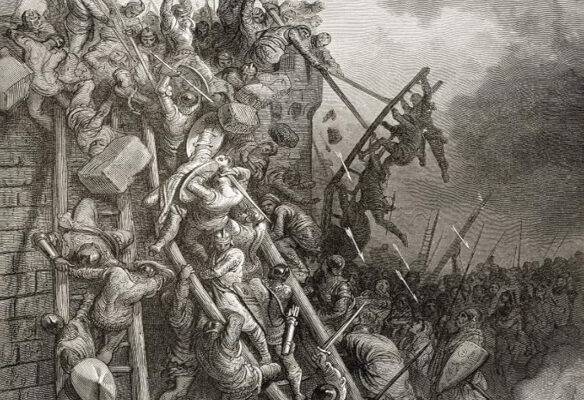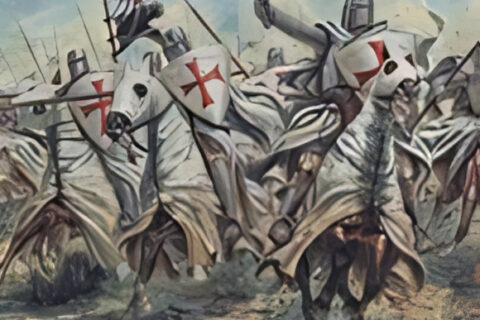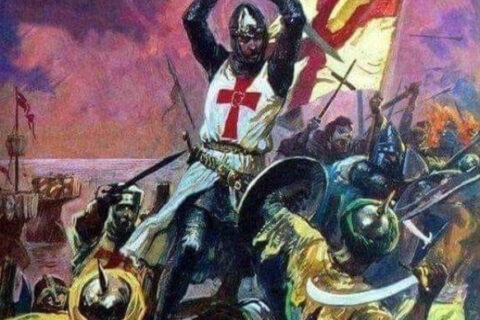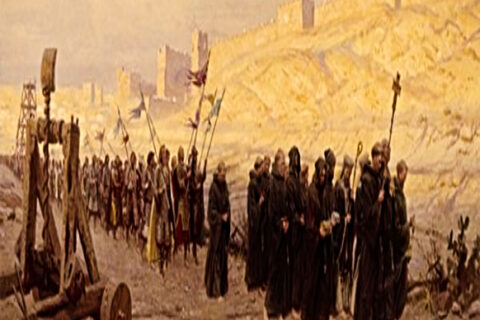Sins of the Crusaders – Anti-Jewish Racism?
In the previous article we addressed the claim that race or religious intolerance drove the Crusaders to the Holy Land, and showed that was not the case. But what about the Jews? Didn’t the Crusaders decimate the Jewish population on their way to the Holy Land? In Europe, weren’t Jews discriminated against and placed in ghettos as an early form of segregation?
I have argued that a unique period of European history, the Middle Ages proper (aka Christendom), existed between 700 and 1300. As with any other time or place, looking at this extensive period spanning dozens of realms, we can find examples of mistreatment and exploitation of minority groups. My claim is not that discrimination against Jewish populations did not occur, but that those events and actions were not as widespread as is believed, and tolerance was the norm. The Crusaders were not bloodthirsty religious bigots!
Crusader Violence
“[King] Coloman may also have regarded Emich as a dangerous liability, his reputation for violence and flouting of royal authority preceding him. In the three months since embarking on his crusade, Count Emich had, in the eyes of many, indelibly stained the holy project by the systematic persecution of Jews.”
Christopher Tyerman, God’s War: A New History of the Crusades
Imagine if today I were to lump all Americans through the centuries as being psychopathic cult leaders like Jim Jones, or serial killers like Jeffrey Dahmer, or terrorist murderers like Timothy McVeigh? You would think me an idiot, and rightly so. Yet, that is exactly what we do with the Crusades. We take the exception and make it the rule. We generalize a diverse group of people with one strict understanding of them.
The most famous incident of anti-Jewish action during a Crusade was led by Emicho, as the above-mentioned Count Emich is usually called, a man the medieval Jewish historian Solomon bar Simson referred to as the “enemy of the Jews.”[1] Bar Simson records the horrific story of a Jewish woman who killed her own children to avoid them being kidnaped and raised “in the way of error” as Christians.
Emicho was a count near the Rhine in Germany, and according to a Bavarian monk and chronicler of the first Crusade, he was “a man long of very ill repute on account of his tyrannical mode of life.”[2] He garnered a sizable following (yet minuscule compared to the other Crusader groups) and headed toward the Holy Land. Along the way, his followers looted, raped, killed, forcibly converted, destroyed synagogues, attacked Jews at multiple places and used antisemitic rhetoric to justify their actions against them.[3] These events and other similar ones are then used to paint all Crusaders with the same mindset, opinions, and actions. But this account is only partially accurate; as usual, there is more to the story.
Peter the Hermit delivered powerful speeches that stirred up strong emotions among the people. As a result, unprepared mobs set out on their own crusade to the Holy Land, separate from the more massive, well-funded and well-organized aristocratic “princes’ crusades.” As their supplies quickly ran out, these unorganized mobs began attacking both Christians and Jews, whoever was nearby.[4] There was a large population of Jews in the area who had what they were after, wealth, and so they used anti-Jewish rhetoric as an excuse to steal from them. It was not necessarily hatred of Jews that led to these atrocities. Rather, it resulted from their failure to plan responsibly. Jews were a vulnerable minority and were wealthy, making them an easy target for the unorganized and ill-prepared “Crusaders.” Money was the main motivator.[5]
Emicho’s mob that attacked Jews was condemned by the Church and resisted by local bishops at each turn, who, at times, were willing to die to protect Jews from the unruly mobs.[6] When Emicho’s rampaging followers attacked Jews along the Rhine, the Bishops of Speyer, Worms, Mainz, Metz, and Cologne sheltered and protected Jews from them. Bishops allowed Jews who were forcibly baptized to revert to Judaism, and helped rebuild destroyed synagogues. For one, it was against Catholic law to forcibly convert anyone, and contemporary writers condemned their actions.[7] Further, the Pope condemned Emicho and his followers.
Knowing the mob’s rapacity and violence, even the Christian residents of Mainz fled before its coming. Bishop Ruthard referred to the looters as “intolerable company.”[8] He permitted Jews to enter his sanctuary in Mainz as protection, only for them to be killed by the mob. When Emicho arrived in Cologne, the Jews had scattered into the countryside, protected by local Christians. Johann, the Bishop of Speyer, saved Jews from the oncoming mob by hiding them and, after, went and punished those who had killed Jews, including cutting off hands.[9]
Bishops protected Jews and hid their assets so well the mob began avoiding the towns with a local bishop to make their plundering easier.
Emicho’s Defeat at the Hands of Christians
Knowing Emicho’s mob were looters, the Christian King of Hungary barred their entry whilst allowing the much larger Crusader groups to pass through. Yet, Emicho and his followers entered anyway and began pillaging as usual. When they did, the local bishop and knights attacked and defeated them, killing many, the survivors either returning home, as Emicho himself did, or dispersing to join other Christian armies.[10] Clearly, they were seen as a threat to all, not just Jews but also Christians who opposed them. This was not so much a religiously motivated attack, as an unprepared and desperate mob bent on destruction that all resisted.
His group and their actions were condemned across Europe from the Pope to the princes, local bishops and citizens, and other Crusaders. Historians of “the princes” Crusade believed God brought judgment down upon them for their acts against the Jews, especially for trying to do what the Catholic Church and God forbade: forcibly convert others.[11] They were even said to be not true Christians but worshippers of idols!
The Second Crusade – Saint Bernard
Knowing of the attacks on Jews by unruly mobs during the First Crusade, the fiery preacher and most influential person in igniting the ill-fated Second Crusade (and, along with Aquinas the most influential Medieval Saint), Saint Bernard of Clairvaux, wrote letters condemning any potential attacks on Jews, saying “Ask anyone who knows the sacred scriptures what he finds foretold of the Jews in the psalm” and “not for their destruction do I pray.”[12] And “Jews are not to be persecuted, nor killed, nor even forced to flee.”[13] He threatened that anyone who attacks a Jew and tries to kill him is as though he attacks Jesus himself. He asked the Church to pray for the salvation of the Jews daily![14] After all, the great Doctor of the Church Augustine of Hippo said if anyone killed a Jew they would face God’s vengeance.[15]
However, in 1146, a local monk (in the same area where the First Crusade attacked Jews) began preaching that the Jews were the enemies of Christ. In response, Saint Bernard rode out to confront him, refuted him in public debate, and then banished the monk back to his monastery in Mainz.
In the end, the persecution of Jews during the Crusades was localized to an unruly, ill-prepared mob in a small section of Europe. These exceptions should not be used to paint the Crusades as some anti-Jewish movement or crusaders as bigoted anti-Semites. The princes’ crusade condemned the mobs, as did local citizens, local bishops, contemporary saints, and the Pope. Further, Jewish villages with synagogues operated in the Crusader States and were allowed the freedom to worship and to be governed by their own elders, even in Jerusalem, where they were previously forced out. At their request for help, Crusaders helped free Jews from Muslim control in 1212 in Spain, and Christians helped defend Jews from Muslim invaders.
Jews in Europe
There has never been perfect harmony between separate groups throughout history. However, antisemitism increased from the 14th century onwards as the Renaissance replaced Christendom, or as the Middle Ages and localism gave way to early modernism and centralization as Roman law reappeared.[16]
Before the 14th century, localized politics ruled, allowing diverse groups of thought, religion, and opinion to be unhindered by larger majorities; the larger majority was also undisturbed by the various minority groups, and thus, everyone had their own way of life and customs; they achieved self-rule.[17] Racism of one kind or another has always been an issue, but was intensified by the centralization of political power, forcing distinct groups into the same political system where a majority rules. People began despising the “other” groups they contested with for control, blaming them for their loss of self-government. Scholar Henry Kamen wrote, “Before the advent of the modern (‘nation’) state, small autonomous cultural groups could exist without being subjected to persecution… the coming of the centralized state, in post-Reformation Europe, removed that protection and aggravated intolerance.”[18]
Given the persecution Jews faced under Roman and later Islamic rule, as well as from the 17th century on, the Middle Ages, especially in their earlier centuries, were the most tolerant of Jews. Laws as well as the Church and the lords protected Jews.
For example, during the 12th century Pope Innocent III wrote, “No Christian shall do the Jews any personal injury… or deprive them of their possessions… or disturb them during the celebration of their festivals.”[19] In 1272, Pope Gregory X ruled that, just as no Jew could testify against a Christian, Christian testimony against Jews was not valid unless another Jew vindicated it (this was in response to a resurgence of the ‘blood libel,’ where Jews were falsely accused of kidnaping Christian children for sacrifice).[20]
A historian of Jewish persecution, Léon Poliakov, wrote, “Kings, nobles and bishops granted Jews a broad autonomy. Thus, they administered their own communities and lived according to their own laws… Jews continued to mix freely with Christian populations and to live on excellent terms with them… until the 11th century, no chronicles mention outbursts of popular hatred of the Jews.”[21]
Perhaps more so than at any time, during this era, the Church was preoccupied with the Old Testament, Jewish apostles, and Jesus, and returning to its origins; it was not antisemitic.[22]
Jewish Ghettos: Self-Governance?
In pre “tolerant,” and “diverse” societies under democracy, people would rather live as they wish, often regulated by their faith in God and how He wants them to live, which was far more vital than being accepting of and under the authority of other cultures, dietary laws, politics, and religion that they thought they were not true. By and large, neither Jews, Christians, nor Muslims desired to live integrated but separated under their own customs, achieving their own self-governance; the same was true of politics. The democratic mindset of survival of the fittest, only the strongest rule and govern others through mass voting, was not their mindset. It did not matter if you were a minority. You still desired self-governance, not the majority, under your ways and your people’s customs.
Jews were safeguarded by law under the protection of lords and kings. Historian Thomas Madden said, “Jews were under the protection of the feudal lord.”[23] Lords and kings would advertise to Jews and offer them a location and place of their own to live according to their own religion and preferred politics.
Far from modern racial segregation, the Jewish “ghettos” offered Jews protection and the ability to achieve what modern citizens lack: self-governance. Professor Hans-Hermann Hoppe has elaborated on this topic, stating, “The much-maligned Jewish ghettos, which were characteristic of European cities throughout the Middle Ages, were not indicative of an inferior legal status accorded to Jews or of ant-Jewish discrimination. On the contrary, the ghetto was a place where Jews enjoyed complete self-government and where rabbinic law applied.”[24]
For example, in 1157 the Holy Roman Emperor Frederick I set aside land for Jews to relocate them so “no bishop or his official, and no count, Schultheiss, or another official except those whom they choose from among their own number, shall exercise any authority over them.”[25] If any Christian takes a Jew’s property, he must return it double. He offered them tools and tax exemptions while trading in the realm, forced baptism was outlawed, and they could have Christians working under them as hired servants. In court, a Jew’s word was to be trusted against a Christian who stole from him. In court, “The Jew has the same right as the Christian to prove his case and to release his sureties by his oath and the oath of another person of either law (i.e., Christian or Jew).” Jews could always appeal court cases to the royal courts.
In 1084, the Bishop of Speyer thought it would “greatly add to [the] honor”[26] of his lands if he invited Jews to live in his village and city. He built a wall for their protection around a section of the city and provided them with some fields, which he bought and gave himself and received donations for. He also provided burial grounds near a church for them and their descendants. They were given liberty to conduct trade as they wished and to establish their own courts, which their leaders judged. They could also hire Christian servants and workers.
Further, it was not discrimination that kept Jews out of certain trades, but rather the fact that some guilds and their members were required to take Christian oaths. Jews tended to prefer buying from their own community, just as Christians, who were the majority of the purchasing population, were more likely to buy from their own.
Spanish Jews
As with Jews across Europe, the 14th century was a turn for the worse for Spanish Jews. Previously, during the 13th century, King Alfonso X of Castile ruled peacefully over Jews, Muslims, and Christians and called himself ‘the king of the three religions.’ In previous centuries, historian Will Durant wrote, “Those centuries, the tenth—eleventh, and twelfth—were the golden age of Spanish Jewry, the happiest and most fruitful period in medieval Hebrew history.”[27]
As a rule, Spanish Jews were well educated, financially well off, owned a large section of land, and self-governed autonomously under the king’s charter.[28] They were elevated to powerful royal and financial positions within the king’s realm and engaged in open and honest debates with Christians.[29] Unlike Christian populations, they did not suffer from starvation and across Europe, Jews owned Christians as slaves, arousing the ire of Pope Innocent III.[30] Many Jews traveled from Muslim nations to receive better treatment in Spain.[31] Jews also taught at top universities.[32]
Not till 1313 did the persecution and separation from Jews in Spain begin.[33] During the 15th century, Spain instituted true ghettoes to segregate the Jews for their own protection from the increasing mob violence.[34]
The increased intolerance that arose in the 15th century was due to the 14th when Jews in Spain accumulated power, and many converted to Catholicism. The Jews’ positions of power in royal office or in banking and their role in collecting taxes made the people resent them. As a result, attitudes towards Jews began to worsen, and they were targeted and displaced. Although the Pope condemned them, anti-Jewish laws were passed in 1449.[35] However, at that time, the Pope and the Church no longer had the power they once enjoyed.[36]
The expulsion of the Jews from Spain in 1492 is pointed to as a prime example of discrimination against Jews. Other instances also occurred in France, for example, in 1306, and England in 1290. Sometimes, Jews were expelled not due to discrimination but because the government could no longer care for them.[37] Other times, it was as an excuse to rob their great wealth when monarchs (as opposed to medieval kings[38]) were in debt. Other times, Jews were kicked out, but so were merchants, and given the Jewish connection at the time (as these occupations were strongly disapproved of or actually illegal for Christians), kicking out Jews was nearly synonymous with expelling merchants, money lenders, etc. In other words, expulsions often were more political or financial than religious.
Stereotypes
Some negative stereotypes of Jews existed and arose during the medieval period. In many ways, the rural aristocracy and the Church took a harsh stance against usury, trade, profit, etc., and Christians were generally not allowed to engage in this type of work. After the rise of capitalism and trade and the growth of urban populations during the 14th century, Jews often took up the profession of money-lending. However, this occupation was not viewed as respectable in societies like feudal Europe, where money, trade, and profit were considered exploitative and corrupt. As a result, Jews were often perceived as greedy and untrustworthy.
In the mid to late 14th century, bubonic plague (the ‘Black Death’) ravaged Europe. Many Jewish communities, however, were spared its devastating effects because they adhered to Moses’s laws regarding sanitation and to dietary laws.[39] Many Christians did not follow these laws,[40] and as a result, many believed Jews were poisoning wells in a secret plot to take over Europe. The plague fueled suspicion and hatred of Jews, as desperate and suffering people looked for someone to blame for the horrors they experienced. However, local bishops put a stop to the persecution. Pope Clement VI declared these accusations false and directed the local priests and bishops to prevent further persecution. He also declared that anyone who continued to persecute the Jews would be excommunicated.[41]
Antisemitism existed in the Middle Ages and among Crusaders, yes. But as this and many other examples given here show, it was by no means a universal phenomenon.
[1] (“Jacob Marcus, The Jew in the Medieval World: A Sourcebook, 315-1791, (New York: JPS, 1938), 115-120”)
[2] (“Emicho and the Slaughter of the Rhineland Jews”)
[3] This was justified by falsely associating modern Jews with those who were responsible for the death of Jesus Christ. Even so, the Romans killed Jesus not the Jews, and, according to Christian doctrine, it was human sin that caused his death going back to the Fall of Man in Genesis. In other words, each individual’s sins led to the crucifixion of the Messiah. Further, Jesus himself was ethnically and religiously, Jewish!
[4] (Stark 2017 20)
[5] (Tierney and Painter 252-253) (Tyerman) (Weidenkopf 2014 56)
[6] (Stark 2010 126-127)
[7] (Asbridge 2005 85)
[8] (“Emicho and the Slaughter of the Rhineland Jews”)
[9] (Weidenkopf 2014 55)
[10] (Stark 2017 20-21)
[11] (“Emicho and the Slaughter of the Rhineland Jews”)
[12] (Madden 2005 54)
[13] (Weidenkopf 2017 287)
[14] (Carroll 1993, 62)
[15] (Stark 2017 27)
[16] (Peters 80)
[17] (Smith and Hedberg Jr. 2024)
[18] (Kamen 10, also see 159)
[19] (Durant and Durant 388)
[20] (Durant and Durant 389)
[21] (Stark 19)
[22] (Smith and Hedberg Jr. 2024)
[23] (Madden 2019)
[24] (Hoppe)
[25] (Medieval Sourcebook The Privilege of Frederick I for the Jews, 1157)
[26] (Medieval Sourcebook The Bishop of Speyer Gives the Jews of His City a Charter, 1084)
[27] (Durant and Durant 372-373)
[28] (Durant and Durant 374)
[29] (Fernandez-Morera 112, 123-128)(Anselm Joseph Jacobs) (“Confession of Arnaud Gélis, also called Botheler ‘The Drunkard’ of Mas-Saint-Antonin”)
[30] (Durant and Durant 378-379) (Pope Innocent III: The Keeping of Slaves by the Jews, 1204)
[31] (Durant and Durant 373)
[32] (Durant and Durant 370)
[33] (Durant and Durant 373)
[34] (Kamen 20)
[35] (Peters 82)
[36] (Smith and Hedberg Jr.)
[37] (Durant and Durant 387)
[38] (Smith and Hedberg Jr.)
[39] (McMillen)
[40] At least the sanitation laws. Bohemund explained that sadly during the first Crusade, many people were so hungry that they had to resort to eating non-kosher animals, indicating that following dietary laws was likely widespread, “When we reached Antioch we fought for three months under great difficulty both against the enemy and against famine, which was more severe than had ever been experienced before, with the result that most of us ate of the very foods which are forbidden by law.” (“Anna Comnena: The Alexiad”) Also see (Smith and Hedberg Jr.)
[41] (Stark 2017 23)

Jeb Smith is the author of four books, the most recent being Missing Monarchy: Correcting Misconceptions About The Middle Ages, Medieval Kingship, Democracy, And Liberty. Before that, he published The Road Goes Ever On and On: A New Perspective on J. R. R. Tolkien and Middle-earth and also authored Defending Dixie’s Land: What Every American Should Know About The South And The Civil War, written under the name Isaac C. Bishop. Smith has authored dozens of articles in various publications, including History is Now Magazine, The Postil Magazine, Medieval History, Medieval Magazine, and Fellowship & Fairydust and featured on various podcasts including The Lepanto Institute.






I have to object to footnote #3. Jesus Christ was crucified — AT THE INSISTENCE OF THE JEWS — by the Romans. Acts 2:23, and the gospel accounts of Christ before Pilate, make this plain. Three times Pilate said, “I find no fault in Him”.
Fair enough!
I was at a Bible Camp, in the Poconos in Pennsylvania of around the age of 11, 1990,s start to give an era.
The, sermon was on how how it was not the Roman guard who slain Jesus, however the young man at the time given a dream that it was him/ or we as all individuals.
God Have Mercy on me!
Great articles,
Sir Smith!
Stereotypes are earned, not assigned. GC is absolutely right: Pilate tried THREE times to free Jesus. But he was howled down by a rioting Jewish mob. “His blood be on us and our children!”
A couple of other historical points:
1. Some Jews DID, and probably still do, kidnap and murder Christian children. Look into Bloody Passovers by Ariel Toaff, a book Jewry moved Heaven and Earth to suppress. There was also a famous trial case of Christian child sacrifice in Italy regarding one Juce Franco. There are other examples, although the usual suspects are working hard to expunge them all from the Internet.
2. Jews WERE caught trying to poison the wells of Christians during the time of the Black Death. See Philip Ziegler’s book, The Black Death. Word got out about this.
3. Communism
4. The Spartacist uprising
5. Judeo-Bolshevism
6. The Lavon Affair
7. The attack on the USS Liberty
8. 911 (Israel’s fingerprints are all over that)
9. Pornography
10. Abortion
11. The drug trade (legal and illegal)
I’m not saying Jews are under every anti-social, anti-Christian rock you kick over. But they’re under many of them. And when you come back and look again at the ones you’ve already kicked over, well there they are.
Thank you, i did not mean to make them out as innocent either. I will especially look into the poisoning of wells. I know they did commit (as does every group) hideous crimes.